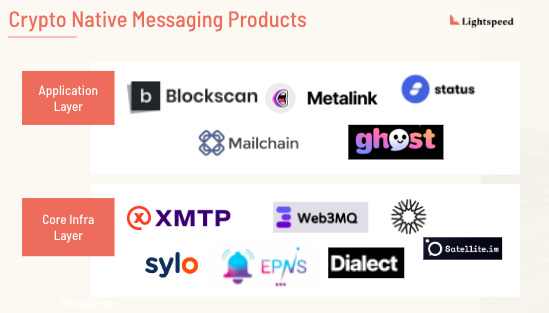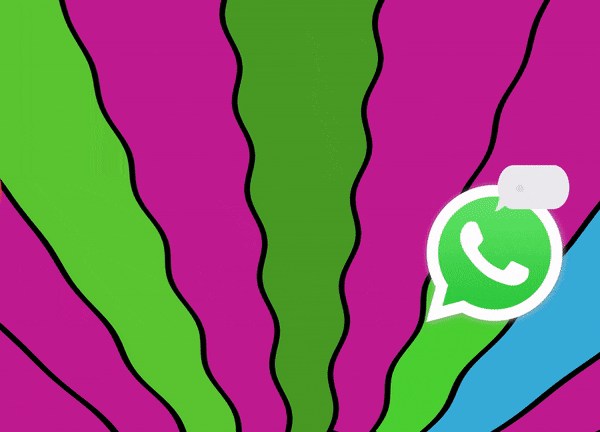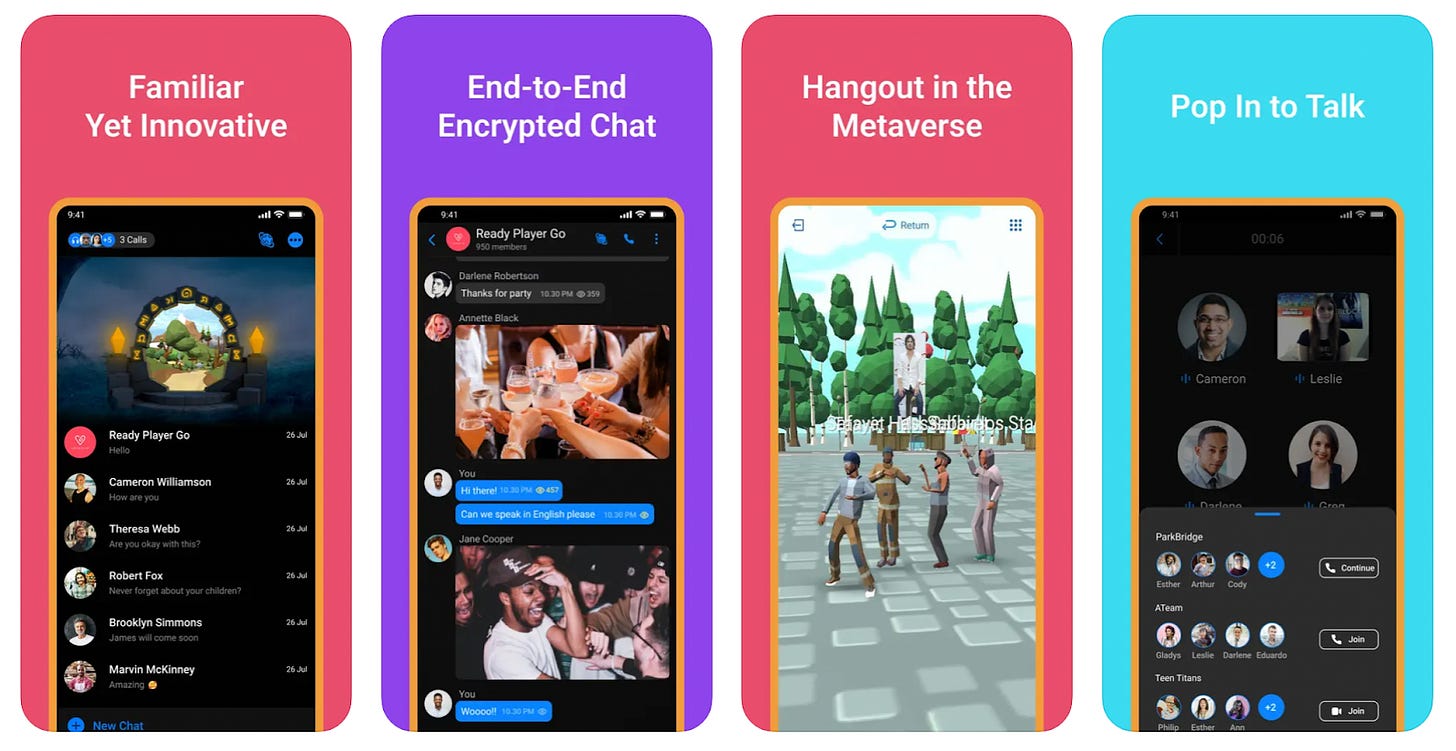Messaging Apps: 5 trends shaping the future
Guess who’s back ? ;)
In 2021, Statista estimated that 3.09 billion cell phone users have used messaging apps to communicate. The leader? WhatsApp with over two billion monthly active users, followed by WeChat, Messenger, QQ, Snapchat and Telegram. Strengthened by this popularity, the latter are expanding their features to achieve both a more fun and utilitarian positioning. And what about the newcomers who are renewing the genre in a radical way? A new Big Bang is brewing behind the scenes, and here's what you need to know.
From enhanced chat to multidimensional.
The days when our communications were limited to text are long gone! Images, GIFs, emoticons, stickers and memes have infiltrated our threads to create a digital vernacular. This new language should continue to be punctuated with sounds and other features, like soundmojis and wordeffects (editor's note: animated text) on Messenger or doodles and custom stickers offered by Viber. Other tools should also allow for more personalized communications, such as HiNote, which brings digital stationery up to speed, or YouGiver, which allows you to send a digital gift via messaging apps. And for early adopters: thanks to the Frenmoji application, you can turn your NFTs into stickers and memes to express your identity differently in your chats. In short, more and more fine-tuning for more visual, more interactive and more differential exchanges.
But there's more. Soon, we should indeed witness the development of "human messaging", i.e., a much more immersive form of discussion. Several startups are already making their mark in this segment. For example, the 2mee platform ― still in beta mode ― has been designed to do everything that a volumetric studio can do and will soon allow you to deliver your messages via hologram. The goal? To help companies and brands create a stronger emotional connection with their consumers. Other startups such as Beem, nextech AR (ARitize Holograms) or Volograms, even if they target the metaverse more than messaging apps, intend to do the same. In 2020, Meta filed a patent for "3D conversations in an artificial reality" which should allow one to generate 3D versions of themself to make video calls.
Let the show begin!
The dazzling development of the metaverse and its applications should also be reflected in our messaging apps. After Snapchat's bitmojis or Facebook's and Tiktok's avatars, they should soon appear on WhatsApp and others. It remains to be seen what kind of experience will be offered... For its part, the British application vTag allows you to create a 3D avatar that you can, thanks to augmented reality, evolve and immortalize in the real world to feed your social networks. A boost for a booming digital fashion sector.
We could also witness new hybrid models of metaverse messengers like the CommChat concept, where users can both chat in the real world while living in the metaverse. In short, a kind of gamified twin world. This is, to some extent, also what the game developer Niantic is doing with it’s recently launched Campfire messaging app for Pokémon. If the principle leaves the Millennial that I am somewhat circumspect, it is clear that the lines between IRL and URL are undoubtedly blurring and that there are undeniably uses to be created (and further defined!). What is certain is that a strong emphasis will be put on entertainment with the addition of mini-games to enrich the chat experiences.
Chat-in/Chat-out for next gen shopping.
What if messaging apps became the starting point for all internet browsing? "In the near future, we will have mini-websites or mini-programs that will run inside messaging applications, as it is already the case for WeChat. Apps like WhatsApp, Messenger or Telegram will become the new Chrome, Mozilla or Internet Explorer," predicts Marc Caballé, founder of Hubtype, a company that develops all-in-one conversational applications for messaging channels.

This is what has been happening for several years in China with the Swiss army knife application WeChat, and the first iterations can already be seen outside the Middle Empire.

European examples include German sustainable furniture brand Woodboom, which has integrated WhatsApp chat-in tabs on the top right of its homepage, under each product description and as call-to-action on its articles. The feature is marketed as a chance to talk to the founder, Mischa. Once shoppers are redirected to WhatsApp, Woodboom agents are trained to sell their products on a very personal level. Finally, once all the questions are answered, a feature called chat-out allows for checkout directly from the chat. The icing on the cake? During the sales process, useful information about the customer is stored to enable agents to get back in touch in a proactive and personalized way, a smooth and ad hoc process made possible by Charles. This startup was initially a fashion brand with a shopping and sales assistance service via WhatsApp. Thanks to their own lessons learned, they eventually pivoted to create a true conversational software for brands.
Another example taken a step further: in India ― which has the world's largest WhatsApp user base ― it is possible to shop for food at JioMart directly from the app thanks to an end-to-end encrypted shopping experience.
Keep my data safe!
At a time when hacks and other breaches are on the rise, the security of personal data is becoming a major issue. This inspires those who are posing as alternatives to WhatsApp & co. with, as their main promise, the guarantee of ultra-secure conversations. Session, Threema, Elixxir, Unit 661, Olvid, Berty and even Signal ― the best known, thanks Elon ;) ― the offer is as plethoric as it is complex for the neophytes.
Among the key points: end-to-end encryption of messages. And beware of the subtleties! For example, while WhatsApp encrypts the content of your messages, this does not apply to the metadata. In other words, the app collects and keeps the phone numbers involved in a conversation, the date and time of the messages, etc., so many elements that can tell someone a lot about you.
Another key point to watch out for is the ability to sign up 100 per cent anonymously, without an email address or phone number. Recently, Signal ― which requires a phone number to sign up ― was hacked in this way, exposing the numbers of nearly 1,900 users. In addition, it is important to know which server each messaging service is running on and to make sure that it is not storing messages. The jurisdiction of the app is also a key issue as most messaging services are American and the CLOUD Act allows US authorities to access data from domestic IT service providers even if the data is not stored in the US. Not to mention, these apps are not really GDPR compliant: Signal, for example, is not compliant with Articles 27 and 28 of the regulation…
As Sarah Bouchkouch from Swiss secure messenger Threema explains: "Cryptography and algorithms are a bit like wine, they get better with age. It takes years and lots of tests before you can say that a cryptographic algorithm is solid. At Threema, that's the case, our latest audit calls our security standards "unusually strong" and that's what our users are looking for: security and protection of their data."
Fun fact: Threema, in addition to offering some of the highest security and data protection standards on the market, has recently seen a resurgence of interest from American internet users. The reason for the buzz? The launch this summer of the series "The Terminal List" on Amazon Prime, which highlights the app's strengths in one of its episodes. A pure coincidence, Internet users even wondered if the application was real or pure fiction. As a result, in July, Threema had its heyday with 246,000 searches on Google, four times more than the previous month.
Wallet-to-wallet messaging.
Today Discord is the go-to chat application for the Web3 community, from NFT projects to DAO communities. The problem? Security. As proof, phishing attacks, especially targeting NFT projects, have become commonplace. As a result, cryptocurrency users are looking for solutions that will allow them to communicate crypto-natively, without having to use web2-based solutions. They also want to use messaging applications that will allow them to communicate with the buyer or seller of a token or NFT without having to know them personally, and to connect to groups based on their cryptocurrency holdings and NFTs in a verifiable manner. Hence, this is unlocking new crypto-messaging products both at the application layer and at the core infrastructure layer.


As Mercedes Bent, consumer VC at Lightspeed, explains: "Consider how we connect today: We reach out to others on LinkedIn based on how attractive their resume is to our own agenda and interests (colleague, sales prospect, title status). We reach out on Instagram because of someone’s aesthetic looks, humor, mutual friends, or the size of their following. We reach out on Twitter because of what a person has written, who else is following them, and so on. In a world where social discovery is based on what’s in someone’s wallet, we will reach out to others based on visible wallet wealth, similar “shopping” or transaction history (...) Polished wallet identities could become the new social media profile."
Slowing down in the digital age.
The question of digital sobriety also arises. While new players are making it their trademark, such as the French company Treebal, which positions itself as the first ethical and eco-responsible messaging service for businesses, all players will have to think about moving towards more eco-design. Dark mode to reduce energy consumption or automatically deleting messages to limit data storage: the list of eco-friendly features is long.
But sustainable communication also means addressing a booming societal issue, namely the mental health of consumers. Among the pain points, over-solicitation and unwanted notifications are the main ones. While WhatsApp has recently announced the ability to filter its discussions to better manage them, we should also see the rise of "silent messaging", tools designed to limit noise pollution. Among them, the "silent exit" — which allows you to leave a group without notifying the rest of the members — or "silent messages" — to send messages without notifications.
We could also witness the development of even more advanced concepts in the face of the stress generated by the discussion threads. Afraid of using inappropriate terms in certain situations? Albert Camus said: "To name things wrongly is to add to the misfortune of the world". In this case, why not rely on apps capable of conveying feelings in ways other than words? In any case, this is the positioning of the messaging app Heallo, which intends to digitalize silence by replacing texts and sounds with halos of light as fragments of emotions to share with loved ones.
The development of haptic technologies (editor's note: Meta announced the acquisition of the German startup Lofelt, which reproduces the sensations of touch thanks to micro-vibrations this week), and wearables should also enrich these calmer conversational experiences and, in the process, signal the advent of mood apps.

One last example to illustrate my point: Happy Ring. This hybrid model is a connected ring, a private messaging app and a social network. It detects stress levels in real time thanks to biometric sensors that measure electrodermal activity (EDA). Once this information is collected, it is automatically shared with the community, which can then — if necessary — showcase their support. Messaging apps, the next trending Mental apps?
MD



